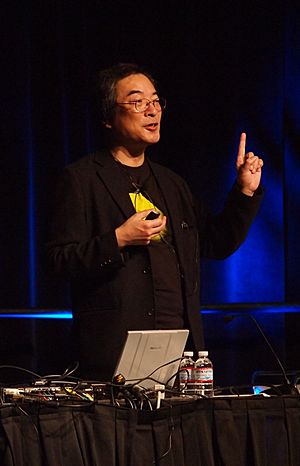Tōru Iwatani facts for kids
Quick facts for kids
Tōru Iwatani
|
|
|---|---|
| 岩谷徹 | |

Iwatani at the 2011 Game Developers Conference
|
|
| Born | January 25, 1955 Meguro, Tokyo, Japan
|
| Occupation | Video game designer |
| Years active | 1980–present |
| Known for | Creator of Pac-Man |
Tōru Iwatani (born January 25, 1955) is a famous Japanese video game designer. He spent most of his career working for a company called Namco. He is best known for creating the classic arcade game Pac-Man in 1980. In 2009, a gaming website called IGN chose him as one of the top 100 game creators of all time.
Contents
Early Life and Education
Iwatani was born in Meguro, a part of Tokyo, Japan, on January 25, 1955. When he was very young, his family moved to the Tōhoku region of Japan. This happened because his father got a job as an engineer for the Japan Broadcasting Corporation.
Later, when Iwatani was in junior high, he moved back to Tokyo. He finished high school at Tokyo Metropolitan University High School. After that, he graduated from Tokai University's Faculty of Engineering. Iwatani learned about computers on his own. He didn't have special classes for programming or graphic design. He often drew manga in his school textbooks. He says these drawings really helped him design characters for his games.
Career at Namco
Iwatani joined the Japanese video game company Namco in 1977 when he was 22. Before he joined, Namco had bought the rights to the Japanese part of Atari, Inc.. This meant Namco could sell many of Atari's games, like Breakout, in Japan. This was a huge success for Namco. It made them want to create their own video games instead of just selling games from other companies.
When Iwatani started, he was put in the video game development team. He first wanted to make pinball machines. However, Namco leaders said no because of problems with patents. As a compromise, Iwatani was allowed to make a video game that was like pinball. With help from programmer Shigeichi Ishimura, Iwatani created Gee Bee. This game came out in 1978. It wasn't as successful as Namco hoped. But Gee Bee helped Namco get started in the growing video game market. Two more games, Bomb Bee and Cutie Q, came out in 1979. Iwatani worked on these as a designer.
Creating Pac-Man
By late 1979, Iwatani felt disappointed with the video game industry. He thought most games, like violent "war" games such as Space Invaders or sports games like Pong, only appealed to boys. He wanted to make a game that girls would enjoy too. He aimed for cute, colorful characters and simple gameplay. The main idea was based on eating.
Iwatani worked with a small team of nine people to create Pac-Man. The game was first tested on May 22, 1980. It was released in Japan in July and in North America in October of that year. Pac-Man was only moderately successful in Japan. Namco's own game, Galaxian, did better there. But in North America, Pac-Man was a massive hit! It quickly sold over 100,000 arcade machines. It became the best-selling and highest-earning arcade game ever.
Pac-Man is now Namco's most successful video game. It is also the company's most famous title. After Pac-Man was released, Iwatani was promoted at Namco. He eventually helped manage the company. Even with Pac-Man's huge success, Iwatani did not get a special bonus or a raise in salary. There's a common story that Iwatani left Namco because he was angry about not getting more money. However, he has said this story is not true.
Later Work and Teaching
In 1983, Iwatani designed Libble Rabble. This was a puzzle game where you used two joysticks. It was based on a game he played when he was a child. Iwatani says Libble Rabble is his favorite game. He also worked as a producer for many other Namco arcade games. These include Rally-X, Galaga, Pole Position, Ridge Racer, and Time Crisis.
From April 2005, he taught about Character Design Studies at Osaka University of Arts. He was a visiting professor there. Iwatani left Namco in March 2007. He became a full-time teacher at Tokyo Polytechnic University.
Iwatani returned to his Pac-Man roots in 2007. He developed Pac-Man Championship Edition for the Xbox 360. He has said this will be the last game he develops.
On June 3, 2010, at the Festival of Games, Iwatani received a special certificate. It was from Guinness World Records. The award was for Pac-Man having the most "coin-operated arcade machines" installed worldwide. The record was 293,822 machines. This record was set and recognized in 2005. It was written in the Guinness World Records: Gamer's Edition 2008.
In the 2015 sci-fi comedy movie Pixels, actor Denis Akiyama played Iwatani. Iwatani himself had a small role in the movie as an arcade repairman.
Games Designed or Produced
| Year | Title | Role |
|---|---|---|
| 1978 | Gee Bee | Designer |
| 1979 | Bomb Bee | |
| Cutie Q | ||
| 1980 | Pac-Man | |
| Rally-X | Producer | |
| 1981 | Galaga | |
| 1982 | Pole Position | |
| Super Pac-Man | Designer | |
| 1983 | Pole Position II | Producer |
| Libble Rabble | Designer | |
| 1984 | Pac-Land | Producer |
| 1987 | Pac-Mania | Director |
| Quester | Producer | |
| 1993 | Ridge Racer | |
| 1995 | Time Crisis | |
| 2007 | Pac-Man Championship Edition | Project Supervisor |
Writings
- Iwatani, Toru (2005-09-17). Pakkuman no Gēmu Gaku Nyūmon. Enter Brain. ISBN 978-4757717527.
- Iwatani, Toru (2012-06-21). Gēmu no Ryūgi. Ohta Books. ISBN 978-4778313265.
See also
 In Spanish: Tōru Iwatani para niños
In Spanish: Tōru Iwatani para niños

